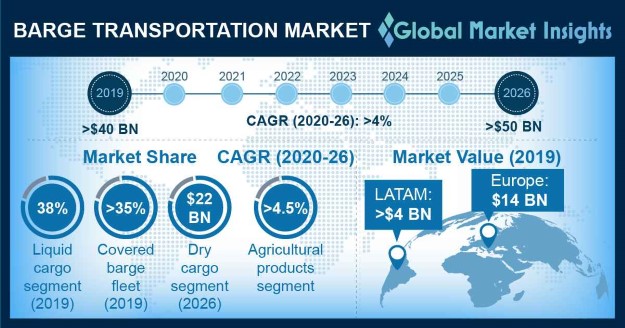Barge transportation market to amass hefty returns from coal and crude petroleum applications over 2018-2024, APAC to emerge as a key revenue pocket
Publisher : Fractovia | Published Date : 2018-10-18Request Sample
Growing local and international trade has substantially propelled barge transportation market, with consistent advancement of industries like automobile manufacturing, energy, construction, oil & gas and food processing. The expansion of these sectors has primarily been influenced by the increased purchasing power of consumers which has escalated the demand for goods and power, enabling global businesses to utilize international and domestic transportation channels. Characterized by being more cost effective and causing lower emissions as compared to some other alternatives, rising preference among exports to use barges for intercontinental conveyance has propagated the barge transportation industry. Leading to lesser spills and offering better load carrying capacity than rail or roadway transport ways, the barge transportation market was able to accrue remunerations of more than USD 121 billion in 2017 globally.
U.S. Barge Transportation Market, By Product, 2013-2024, (USD Million)

Studies have proven what most of the industries are already aware of, that barges are one of the most efficient means of transport. Goods-specific barges can perform even better, and the barge transportation industry is gradually becoming a crucial part of the energy policies of countries focused on utilizing lesser fuel. The previous year, a report commissioned by the U.S. National Waterways Foundation revealed that inland river barge transportation was delivering better fuel efficiency than road or rail. The study showed that a ton of cargo can be moved 647 miles on a barge with 1 gallon fuel, where as the numbers for train and trucks were 477 miles and 145 miles per gallon respectively. Subsequently, increased adoption of waterways for transporting goods and resources will give tremendous propulsion to the global barge transportation market.
In terms of transporting resources, the steady annual growth in the demand for energy and vehicle fuel has created a promising application segment for the barge transportation industry from the export of coal and crude petroleum. The Asia-Pacific (APAC) region, particularly, has been a major importer and consumer of crude over the past decade, mostly driven by the enormous population base which proliferates the automobile and power generation sectors. Statistics indicate that the demand for crude in APAC had gone up from 9.1 million bpd in 1973 to 34.6 million bpd in 2017, which is effectively a 280% increase. Countries like China and India witnessed accelerated growth rate over the past 20 years, offering opportunities for crude petroleum exporters as well as companies in the shipping and barge transportation industry.
According to the International Energy Agency, China would be overtaking U.S. as the world’s biggest crude oil importer over the next five years, with APAC estimated to contribute nearly 60% of global demand during the period. Coal, which is burnt to generate electricity, is also a lucrative application area for the barge transportation market as it still powers 40% of energy consumption in emerging markets. Reports say that throughout 2017, coal-powered electricity generation plants had increased across most of APAC’s key economies, boosting demand for the natural resource and presenting growth prospects for coal providers in countries like Australia, where the quality of coal is high. With development of the manufacturing sector in China, India, Malaysia, Indonesia and other South East Asian nations, the upsurge in power requirements will positively transform the barge transportation industry in the region.
With the U.S. and a number of African countries exporting crude to the APAC region, there is not expected to be any halt of supply over the coming years that could disrupt the shipping industry. Even the ongoing trade wars between the U.S. and China have only diverted U.S. exports from China towards Japan and South Korea, maintaining the crude flow into the region. The barge transportation market has benefitted from the extensive river routes in Asian countries, which pass through a large number of cities, providing a means of affordable coal and crude supply. China, for instance, has over 110,000 kms of navigable rivers with more than 1200 million tons of goods being transported on these rivers every year. For the record, the APAC barge transportation market was valued at USD 34 billion in 2017.
All in all, owing to the continuous rise in foreign and domestic trade in metals, chemicals and other goods, global barge transportation market is likely to traverse alongside a highly profitable growth path. American Commercial Barge Line, SEACOR Holding, ABC India Ltd., Campbell Transportation, Canal Barge, PTC Logistics and PACC Offshore Holdings are some key participants forming the competitive spectrum of barge transportation industry.